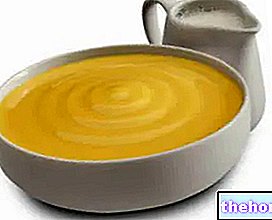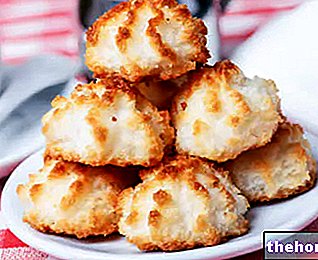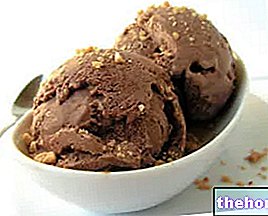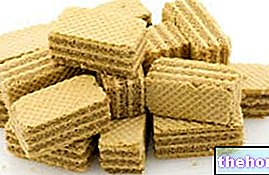Generality
Cocoa biscuits are dry pastry sweets.
Let's start by specifying that cocoa biscuits and chocolate biscuits (covered or with pieces in the dough) have completely different recipes.

Cocoa biscuits are well known and widespread all over the world.
The chemical composition can vary greatly depending on the recipe.
Cocoa biscuits are very caloric foods, even if the specifications vary considerably from one product to another. The excess energy is caused by the amount of fat and / or lack of water in the compound; moreover, simple sugars are in percentage excess.
Microwave Cooked Cocoa Cookies - Ready in 8 Minutes
Problems with playing the video? Reload the video from youtube.
- Go to the Video Page
- Go to the Video Recipes Section
- Watch the video on youtube
Nutritional Characteristics
Cocoa biscuits should have an important caloric intake; as anticipated, there are many types and the nutritional characteristics can vary significantly. Below we will try to highlight the most significant differences referring to the types most common today.
The less energetic type of cocoa biscuit is undoubtedly the wholemeal one or the one with added fiber. The difference between the two variants is that the first contains exclusively wholemeal flour, while the second provides for the addition of pure fibers such as bran, gums solubles, inulin etc.
The other ingredients that can affect the calorie density of cocoa biscuits are:
- Fatty foods: butter, ghee, margarine, vegetable oils. They tend to increase total energy.
- Calorie sweet foods: granules, honey, maple or agave syrup, etc. are added to sweeten and tend to increase the final calories.
- Non-calorie sweeteners (natural or synthetic): stevia, cyclamate, aspartame etc. tend to lower the total energy.
- Other: oil seeds (walnuts, almonds, pine nuts, flax, etc.), chocolate, grains, etc. tend to increase the final calories.
The prevailing energy macronutrients of cocoa biscuits can be fatty acids or carbohydrates (simple or complex), depending on the recipe.
- With large quantities of butter or oil, for example for cocoa shortbread biscuits, or in sweets rich in dried fruit (in pieces or in flour) or with a lot of chocolate, lipids prevail.
- On the contrary, sugars (simple and complex) seem more abundant in cocoa biscuits.
The "diet" cocoa biscuits, on the other hand, can reveal a greater quantity of proteins than fats and sugars, but always lower than the sum of the two. Generally they involve the addition of peptides from soy, casein from milk or whey; recently cricket flour (protein and extracted from insects of the same name) has been introduced.
In addition to the absolute quantity, the percentage of fatty acids can also change significantly. Certain ingredients are rich in saturated lipids (butter, lard, coconut oil, avocado oil, palm oil or palm kernel, various bi-fractionated or hydrogenated tropical oils, etc.). Others contain many unsaturated lipids (monounsaturated or polyunsaturated, such as corn, peanut, olive, hazelnut, etc.).
The ingredients of animal origin, with the exception of isolated proteins, contain cholesterol; the most influential are egg yolks, butter, lard and whole milk.
Natural calorie sweeteners increase the share of simple sugars (sucrose, glucose, fructose, maltose) compared to that of complexes (starch).
Fiber is most abundant in whole grain recipes and with added fiber. Diet biscuits (for example against constipation or for diabetics) bring a higher quantity of water-soluble molecules (from algae, roots, berries, etc.) compared to the classic insoluble “bran” of cereals.
Wholemeal cocoa biscuits with added fiber, in addition to having fewer calories, also have a lower glycemic load and index; they lend themselves more to the diet against overweight, hyperglycemia and hypertriglyceridemia.
In addition, they contain more vitamins and minerals; specifically, there is an increase in: thiamine (B1), niacin (PP), potassium, phosphorus and magnesium.
It also significantly increases the amount of antioxidants.
Moreover, by using “proper” whole wheat flour (containing wheat germ, the amount of vitamin E and essential omega 3 fatty acids is raised.
Due to the excess of fats (saturated and cholesterol), simple sugars and total calories, cocoa biscuits are not suitable for frequent consumption and in significant portions.
This is especially true for people who suffer from overweight, hyperglycemia or type 2 diabetes mellitus, hypertriglyceridemia and hypercholesterolemia.
For those who make extensive use of commercial products, it is good to remember that most recipes include the addition of table salt (sodium chloride). Since sodium is involved in the worsening of sodium-sensitive arterial hypertension, advises against frequent use in those affected by this pathology.
Diet recipes (protein, rich in fiber, sugar free, etc.) can also be contextualized in clinical nutrition, but with a frequency of consumption and a portion appropriate to the case.
Most cocoa biscuits contain lactose and gluten, which is why they do not lend themselves to the diet due to related intolerances.
They can be accepted only by the lacto-ovo vegetarian philosophy or even by the vegan one, depending on the presence or absence of milk and eggs (precluded by the latter).
The average portion of cocoa biscuits is 2-5 pieces (depending on the individual weight), which is about 30 g.
Curiosity
Internationally, the legislation on cocoa and (even more so) chocolate biscuits is more quirky than one might imagine.
The indications of the various countries may differ and require specific characteristics; for example, the total percentage of chocolate in relation to the biscuit, the amount of cocoa butter in the chocolate etc.
Not everyone knows that in England and its surroundings these characteristics are decisive for calculating the applicable taxation such as Value Added Tax (VAT).
In fact, in the UK there is a rule that "luxury foods" such as sweets are "taxable", while basic food products are exempt.
It is curious to learn that jurisprudence and the succession of judgments have defined that chocolate-covered biscuits, such as Chocolate Digestive or the Kit-Kat, are subject to VAT, while i Chocolate-Chip Cookies or i Jaffa Cake they are not.
Other Foods - Sweets Aspic Cantucci Caramel Candied Citron Chocolate White Chocolate Codette Chantilly Cream Custard Crepes Ice Cream Granita Ice Cream Jam and Jam Marshmallow Marzipan Honey Mustard Nutella Sponge Cake Pandoro Panettone Shortcrust Pastry Sorbet Strudel Nougat Wafer Zabaione Iced Sugar OTHER ITEMS Alcoholic Alcohol Categories Meat Cereals and derivatives Sweeteners Sweets Offal Fruit Dried fruit Milk and derivatives Legumes Oils and fats Fish and fishery products Salami Spices Vegetables Health recipes Appetizers Bread, Pizza and Brioche First courses Second courses Vegetables and Salads Sweets and Desserts Ice creams and sorbets Syrups, Spirits and grappas Basic Preparations ---- In the Kitchen with Leftovers Carnival Recipes Christmas Recipes Diet Recipes Light Recipes Women's Day, Mum, Dad Functional Recipes International Recipes Easter Recipes Recipes for Celiacs Recipes for Diabetics Recipes for the Holidays Recipes for S an Valentino Vegetarian Recipes Protein Recipes Regional Recipes Vegan Recipes




























